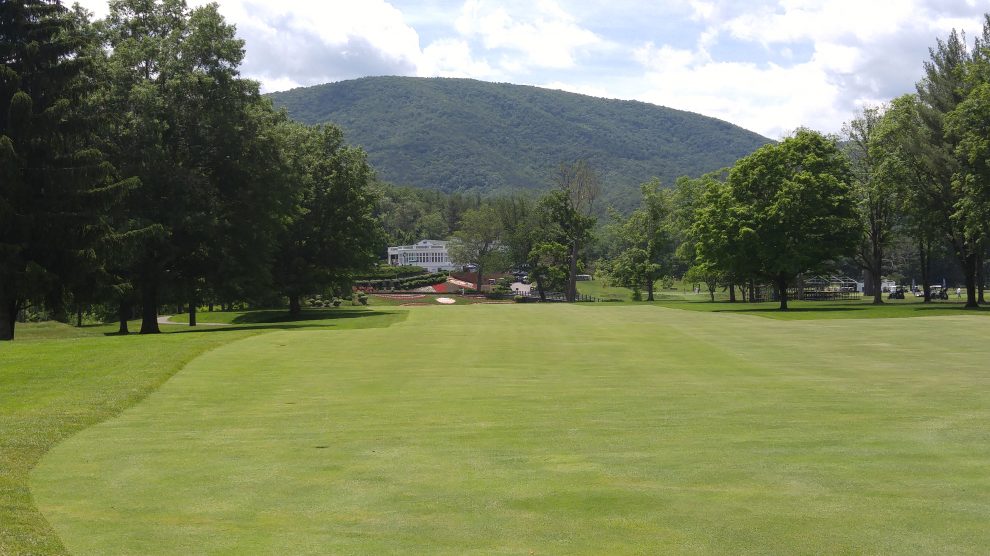The PGA Tour heads due west from our Nation’s Capital to the foothills of West Virginia to play a course that is somewhat out of sorts for a regular tour stop. Meaning, the Old White TPC at The Greenbrier is one of the few Golden Age courses that see regular play year in and year out without hosting the U.S. Open nor PGA Championship.
As you’ll hear numerous times, West Virginia experienced extreme flooding shortly before the tournament last year, which damaged all the courses at the resort and forced the cancellation of The Greenbrier Classic. The golf course had to be closed and has been completely restored by noted architect Keith Foster.
While the routing plan and hole concepts didn't change, every green was rebuilt, every green and fairway was regrassed, the ugly fescue around bunkers was removed and trees were selectively thinned to reintroduce views and sight lines that had been hidden for decades.
Originally designed by Charles Blair Macdonald and Seth Raynor, The Old White opened for play in 1914. One of the best architect combinations that has ever graced the world produced the following courses that are always ranked inside Top 100s: National Golf Links of America, Chicago Golf Club, Fishers Island and the Golf Course at Yale. What they are perhaps best known for is the use of ‘template’ holes. These holes, taken from some of the greatest holes in the British Isles are used over and over with slight variations. In fact, many of the most famous golf holes in the world are some form or modification of a template hole.
Luckily for us, Macdonald and Raynor laid out a few of these template holes at The Greenbrier. Among them the eighth hole was styled after the "Redan" at North Berwick, the 13th after the "Alps" at Prestwick, the 15th after the "Eden" at St. Andrews, and the 18th which is a “Short” after the 5th at Brancaster (now the fourth hole at Royal West Norfolk Golf Club).
These holes are special because the Tour rarely visits courses with this type of history and architectural integrity. They are templates for a reason; requiring specific skills and shot shapes to score well. The holes are meant to be played a certain way, and that’s unique among courses on Tour.
Holes to Watch
Hole 8 - Par 3, 234 yards (REDAN)
This natural terrain allowed C.B. Macdonald to build the ideal Redan hole, modeled after the 15th hole at North Berwick, Scotland. A right-to-left running shot can find any hole location on this diabolical green. A miss to the left will bring the course's deepest bunker into play.
Hole 12 - Par 5, 568 yards (LONG)
A tee shot that carries the cross-bunker will yield the shortest route to the green, but is yet another risk/reward decision. Play the safe route left of center, and be prepared to negotiate the "Hell" bunkers and the creek that crosses the fairway from right to left. The putting green features a false front that will reject most shots leading there. The "Long" design concept is from the 14th hole on the Old Course, St. Andrews, Scotland.
Hole 13 - Par 4, 492 yards (ALPS)
A tee shot that is placed both long and left of center near Howard’s Creek will provide an unobstructed view of the putting green. Cut the corner for a shorter approach shot and be prepared to negotiate the "Alps," whose concept is from the 17th hole at Old Prestwick, Scotland.
Hole 14 - Par 4, 401 yards (NARROWS)
Play straight down the "Narrows" or over the right side cross-bunker and the hole becomes a scoring opportunity. Club selection and skilled shot execution require boldness in order to stay on the small-elevated green with its unforgiving false front. The design concept is from the 15th hole at Muirfield, Scotland.
Hole 15 - Par 3, 229 yards (EDEN)
The Eden is typically a test of a player’s mid-irons. It features a well protected and heavily sloping back-to-front green. The bunkering around an Eden green include one on the left called the “Hill” bunker, a pot bunker on the right the “Strath,” the “Eden” bunker behind the green and the “Cockleshell” or “Shelly” bunker short and right of the green. This version has all of them except the “Shelly.”
Hole 17 - Par 5, 616 yards (ROAD)
The tee shot provides the final risk-reward strategy, like the "Road Hole," the 17th hole at the Old Course, St. Andrews, Scotland. If placed right of center near Howard's Creek, long hitters may be able to reach this par 5 in two. Play safe to the left and a strategic plan will be needed to negotiate the three cleverly located fairway bunkers and the "Dragon's Teeth" along the right side to reach the undulating green in regulation.
Hole 18 - Par 3, 177 yards (SHORT)
Finishing a course with a par 3 is “controversial” but with this fantastic green site and grandstands it lends itself to exciting finishes for tournament play. A short iron shot for most players. Correct club selection followed by skilled execution will yield a par or birdie opportunity. The large ‘thumbprint’ ridge amplified by Foster that dissects the green is intended to test a player's confidence on this final shot.


